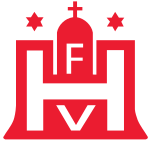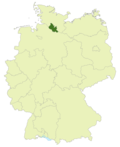Football regional league Hamburg
| State League Hamburg | |

|
|
| abbreviation | LL |
| Association | Hamburg Football Association |
| First edition | 1946 (as 1st class ) 1963 (as regional league ) |
| hierarchy | 6th league |
| Teams | 2 × 17 |
| master |
VfL Lohbrügge (Hansa) , HEBC Hamburg (Hammonia) |
| region |

|
|
↑ Oberliga Hamburg (V) ↓ 4 seasons of the
district league Hamburg (VII) |
|
The Landesliga Hamburg is a soccer division in Hamburg . It consists of the two seasons Hansa and Hammonia and represents the second highest class of the Hamburg Football Association (HFV) after the Oberliga Hamburg and the sixth highest class in German league football . The next lower class is the district league , consisting of the four north seasons , East, south and west.
composition
17 clubs play in each of the two seasons, with the Landesliga Hansa clubs mostly from the south and east of Hamburg and those of the Landesliga Hammonia mostly from the west and north of Hamburg. However, it can be for structural reasons (most recently due to the introduction of the single-track 3rd division and the three-track regional division ) or sporting reasons (e.g. if several relegated teams from the Hamburg Oberliga come from one region or both the first and second teams of a club are in the national league), there may be deviations from this composition.
Clubs 2019/20
| Season Hansa | Season Hammonia |
|---|---|
|
|
Promotion and relegation regulation
The promotion regulation is linked to the performance of the Hamburg clubs in the regional league using a "sliding scale". Only the respective champions of their national league relay are safely promoted to the Hamburg Oberliga ; the runners-up can move up if there are or are still places available. At the end of the 2013/14 season - despite the relegation of Victoria Hamburg to the regional league - both regional league runners-up were promoted to the league because champions VfL 93 renounced and Oststeinbeker SV withdrew from the league. Oststeinbeker SV then continued to play in the district league , while VfL 93 had to start over in the lowest league, the district class. In 2018/19 even five national league teams rose.
Regardless of the number of descending regional leagues, the last three places in the regional leagues must be relegated to their respective district league. The champions of the district leagues move up directly to the regional league relays, the second-placed players play relegation games - how many of them also move up depends on the "sliding scale". The allocation of all relegated and promoted teams to the relays is done in the same way as the geographical location of the clubs in the playing area suggests.
history
When the championship games started again in January 1946, a double-track 1st class was set up below the (city) league and one year later it was expanded to three, and in 1947 even to four relays. These were named Germania , Hansa , Hammonia and Olympia . From the same year, the Oberliga Nord took the place of the dissolved city league; Hamburg's highest division was now a two-pronged association league . In 1949, the 1st class was renamed District Class and in 1950 it became double-tracked again; the old names Elbe-Staffel and Alster-Staffel were initially used . The highest league (below the Oberliga Nord) was now a single-track amateur league in Hamburg .
A new reform of the league structure took place in 1953. Between the amateur league and the district class, the association pushed an association league with the three seasons Germania , Hansa and Hammonia . When the Bundesliga was introduced in 1963 , this meant that the three association leagues were only fourth class (but still second division within Hamburg). At the same time, the top division in Hamburg was no longer called the amateur league, but the state league.
The next change came in 1970. Now the association league was also "lowered" by one level and the unused term amateur league was used for a new, second-highest division with the two seasons Hansa and Hammonia , which still exist today . Apart from other name changes, the basic structure of the top three Hamburg leagues has remained unchanged since then.
The introduction of the 2nd Bundesliga , however, meant that the two amateur league seasons from 1974, counted from the top, were only fifth class. In 1978 the hierarchy in the name was reversed: the top division of Hamburg was called the Association League in the future, while the one below it has since been run under the current name of the Landesliga . The last change so far brought with it the introduction of the regional leagues in 1994: since then, the two regional league seasons in the German league system are only sixth class.
Master since 1971
Individual evidence
- ↑ The structure of the Hamburg League Pyramid has been subject to frequent changes for decades. It is difficult and only makes limited sense to understand these using the league names , because these too have often been changed and replaced. Roughly summarized, it can be said that the second highest division in Hamburg has consisted of two tracks since 1945, with the exception of a longer phase from 1953 to 1970, when there were continuously three seasons.
- ↑ District class Hamburg 1947/48 , www.f-archiv.de (August 8, 2008)
- ↑ District class Hamburg 1950/51 , www.f-archiv.de (August 8, 2008)
- ↑ Hardy Greens : Legendary Football Clubs. Northern Germany. Between TSV Achim, Hamburger SV and TuS Zeven. AGON Sportverlag, Kassel 2004, ISBN 3-89784-223-8 , p. 14.
